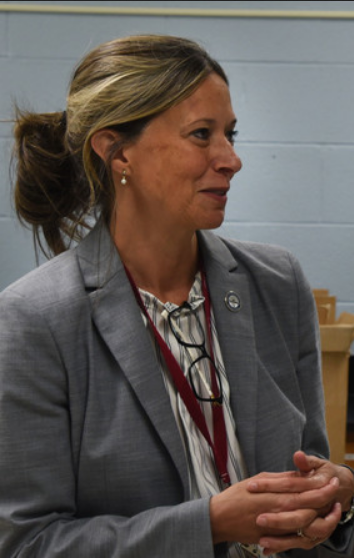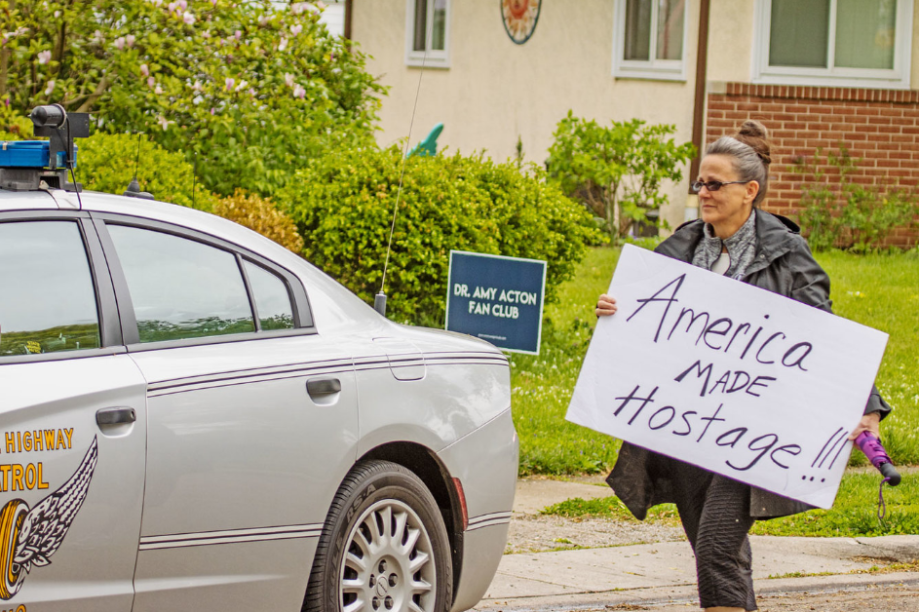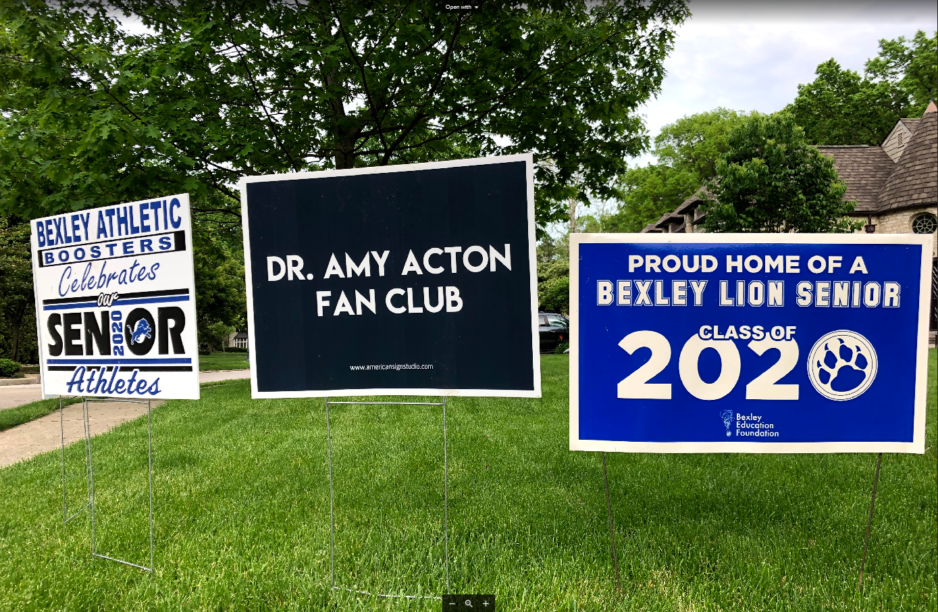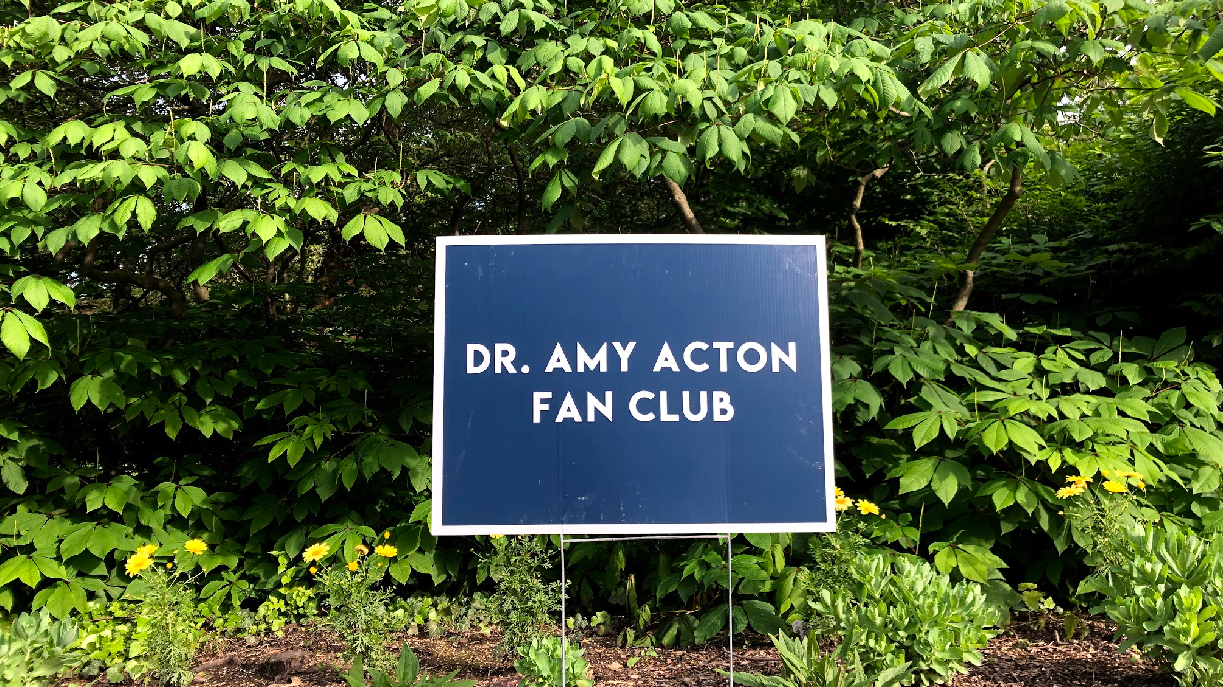In the weeks leading up to the altercation, the tiny, tightly-knit suburb of Columbus known as Bexley, Ohio, amassed a growing number of lawn signs.
If the front lawn is an emblem of the suburban self-image—if, that is, one views evenly-mowed emerald grass and coiffed shrubbery as a signifier of personal values—then the lawn sign is the apotheosis of lawn semiotics; your candidate of choice, your upcoming bicycle race or your child’s sporting event, announcing, plain as day, just who you are.
The lawn sign has always been a fixture of lawns in Bexley (pop. 14,000), my hometown and current location of quarantine. But over the past few months they’ve played a new role, communicating information that can no longer be conveyed face to face. In the early days of the lockdown, one lawn wished a HAPPY BIRTHDAY to PATRICE in individual letters, each the size of a small child. I learned from many homes that A FIFTH GRADE GRADUATE LIVES HERE! Others shared CONGRATS to SENIORS! of various local high schools. These signs sadly proclaimed the suspension of a time when we could honor our children’s matriculation into middle school the way God intended, with a bowling alley pizza party.
As the weeks under quarantine wore on, Bexley began to acknowledge the pandemic more explicitly. In front of a house where my brother used to play video games, a sign asked passersby to PLEASE PRACTICE SOCIAL DISTANCING! Another requested that we SALUTE OUR ESSENTIAL WORKERS.
Online we complain about spring breakers and inept leaders, and wonder at how the hell Germany figured it out so fast. But that’s no substitute for a dinner party or hanging out in a coffee shop. Maybe people in Bexley are meeting something of the need for more tangible interactions by means of lawn signs. Signs that might remind passersby of the real people folded into these homes wrapped in greenery, and of what they would like to say.
I was on a walk one day when I noticed a spiffy navy rectangle planted in the front lawn of an old high school friend. It announced, in tasteful white block letters, the home’s membership in the DR. AMY ACTON FAN CLUB. Soon I noticed a crop of identical signs sprouting around the neighborhood.

Amy Acton is Ohio’s health commissioner. She has received praise for her early identification of the pandemic’s reach, for her calm demeanor and expert medical knowledge. The FAN CLUB sign seemed, at first, to be just another virtue-signaling social-distancing lawn sign. In fact, it was the opening salvo in a pitched battle.
After initial anti-lockdown protests at the statehouse proved ineffective, a small group of thirty far-right Ohioans packed into their cars, drove into Bexley, and stationed themselves in front of Dr. Acton’s house, seeking to compel Ohio’s reopening through more personal tactics. They kept their protest to the public sidewalk in front of the Actons’ home, so as to avoid charges of trespassing.

“It was surreal,” Tim Madison, the Actons’ next-door neighbor, told me. “It was scary.” The protestors arrived “completely out of nowhere, on a beautiful Saturday afternoon,” displaying signs of their own: “LET FREEDOM WORK” and “DR AMY OVER-RE-ACTON HAIRSTYLISTS ARE ESSENTIAL.” There were reports of assault rifles, and assertions that the protest would remain nonviolent “for now.” At second and third gatherings, some of the protestors displayed anti-Semitic signs (Acton is Jewish, as are many Bexley residents). One man began shouting through a bullhorn. Two protestors were identified as members of the Proud Boys, a neofascist hate group. In overwhelmingly liberal Bexley, the open presence of such politics was as offensive as they are unusual.
When the protestors appeared, Acton’s neighbors congregated spontaneously and seated themselves, masked and cross-legged and unflappable, on the lawn in front of them. They created “a wall, if you will,” according to Madison, between Acton’s home and the protestors. In the midst of national quarantine, it was an unusual image: The pro- and anti-lockdown crowds rarely meet in person, because the people who might normally counter-protest the far-right are following quarantine rules and staying home. Here the masked and the aggressively unmasked collided on Dr. Acton’s lawn.
In the before time, when standing in close proximity was not a warning that something significant was happening, we would have just called this a gathering. Now, the description that comes to mind is: human lawn sign.
After the first day of battle, the number of FAN CLUB signs around Bexley swelled appreciably. The spread of signs grows denser near the Acton residence. In the direct vicinity of her house, some lawns bear multiple signs.
On a recent walk with my mother in the neighborhood, we met a woman walking her dog. After a moment of mutual appraisal—during which all parties established that we were longtime Bexley residents—conversation flowed warmly.
The woman introduced herself as Cassandra and said she had watched the protests, all of them, from her front porch a few houses down the road. She found the protestors perplexing, she said. She tried to have a conversation with one of them, she said, to get a cogent sense of their aims, but gave up. “They don’t want to have a conversation. They just want to scream,” she said. The battle lines in this fight are clearly drawn.
 photo: Becker1999 (CC BY 2.0) via Flickr
photo: Becker1999 (CC BY 2.0) via FlickrUntil Tim Madison, Acton’s next-door neighbor, asked me whether I was “a fan of Amy Acton or not,” I had not considered the pandemic in those terms. I am a fan of people not dying, and I thought Acton’s leadership was admirable. I am also not a fan of prioritizing the economy over human life. That puts me squarely on one side.
The army of signs planted around the neighborhood would imply that most of Bexley feels the same. “Everybody in Bexley is mad,” says Lori Ann Feibel, who is president of the local city council (and also the mother of a childhood friend of mine). “Like, don’t you dare do that, to one of us.”
At one of the protests, a man shouted a homophobic slur at a Bexley woman. The police response to this incident was inept, some residents felt, because officers failed to intervene, and concern mounted when a video surfaced of the police chief speaking cordially with a Proud Boy who had driven by on his motorcycle. Bexley PD insisted the chief was de-escalating the situation; some thought his behavior was too chummy. Skirmishes broke out in the Bexley Buzz, a local Facebook group; comments grew quite heated, sometimes personal.
So there is an unusual current of wariness developing around the subject in Bexley. “Please don’t take this the wrong way,” Madison told me, “but with the people who have been protesting in our neighborhood, I’m just a little concerned [about] who I would be making comments to.”
Cassandra told us some of the protestors had returned to the neighborhood. A few had tried, absent the signs and vitriol, to greet her in passing. She recalled one woman who had painted her face “half blue” during a protest. The woman returned, Cassandra said, a few days later, sans face paint. “She was walking a circle around the neighborhood over and over again, with her husband, trying to look like they fit in and smile at everybody,” Cassandra said. “But I didn’t smile back, because I recognized her. Even though her face wasn’t painted blue I recognized her. I didn’t smile back and wave,” she said, “because I got an eerie feeling.”
I grew up in Bexley, as did my mother, as did hers. Bexley has always seemed cozy, sometimes stiflingly so, a place where everyone knows everyone; or at the very least, knows someone who goes on power walks with someone who goes to synagogue with my granny. But under the weight of the pandemic, and all the unprecedented disruption that has accompanied it, something has shifted in my hometown’s tightly woven ecosystem. There is a subtle hardening, as fear turns inward, as we tap our feet and wait it out.
All things considered, I suspect that to the Actons’ neighbors we might have seemed just as likely intruders as the lady with the blue face. What will happen, I wonder, when we emerge bleary-eyed into the new normal?
For a stretch of about a week and a half, Cassandra told me, protestors had been returning, in varying numbers, practically every day. One man came by himself and paced “for two solid hours” in front of Acton’s home. Tim Madison said some had been seen driving around at night.
But the numbers have dropped off by now, and it is unclear when or if the protestors will return, with Ohio a few days into its phased reopening. But if the protestors were willing to come to Acton’s house when quarantine was winding down, who can say what will happen when the second wave of social distancing orders hits, as it inevitably will? And with polarization likely to worsen in the wake of the pandemic, I wonder if this clash might be less an anomaly than an augur of post-pandemic national trends.
I asked Cassandra if she felt scared. Not exactly, she said. “I personally never felt in danger. I found it very… I guess I was surprised,” she said, “not so much that they came to her house, but that they’re so angry.” She trailed off, thinking. “I never got angry, and I lost my job. But I still never got angry.”
At an emergency meeting on May 6, the city council decided it had no legal recourse to stop the protestors. And the neighbors, who’d put their own bodies on the lawn, decided this only fed them attention.
The protestors might return in larger or more violent force, or they might stay away. In the meantime, we mount an increasingly powerful corps of signs to fend them off.
I’ll admit that despite my initial cynicism, the lawn signs of Bexley — celebrating membership in the FAN CLUB, pleas to ACT/ON LOVE, and exhortations to STOP THE SPREAD, even the ones informing us that BEXLEY ATHLETIC BOOSTERS CELEBRATES SENIOR 2020 ATHLETES — stirred in me a sense of something like connection to the people who’d pressed them into the earth. But as is basically true of signage, according to poststructural theory and also to the properties of colored plastic, they carried no innate meaning. They compelled no action, cured no convalescents, paid no workers.
It stormed in Bexley the other day. All afternoon and well into the night, the rain crashed down in thick gouts. I admired its force; its intent, despite the wind, to reach the soil. By morning the lawns had grown shaggy, shooting up in uneven patches. I’d forgotten how fast grass can grow; all around our little town, front lawns begged for a haircut. Green tips tickled the bottoms of the signs. A few more rains and the blades of grass would stretch tall enough to obscure their words entirely.
 photo: Eliya Smith
photo: Eliya Smith





